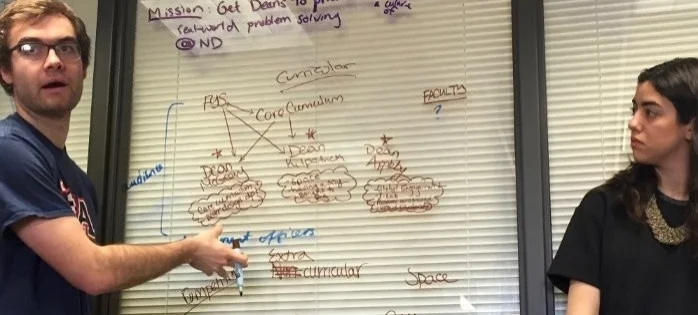“Group project”: two of my least favorite words to read on a syllabus or hear a professor say. When I reflect on past group projects, positive experiences don’t usually come to mind. It always seems that at least one person free rides or that the group has to spend more time making the separate parts cohesive than it would take me to complete the project individually. So when my partner and I had to select a topic to teach a class on in our International Development and Design Thinking course, I was a little skeptical when we landed on high-functioning teams. How could I teach a class on high-functioning teams when I could only thinking of one or two that I had ever worked on? Yet, as we really dove into the topic I became intrigued by the literature around creating high-functioning teams.
My partner and I focused on one aspect of high-functioning teams for our class, though there are many considerations when creating them. We looked at how understanding your strengths and weakness, your personal inventory, and your teammates’ personal inventories can lead to a more conscientious and productive team. We employed a tool created by consulting firm SYPartners, called Superpowers and Shadow Sides to depict this. Superpowers and Shadow Sides is an exercise for teammates to identify their individual strengths and learn how to activate their team’s strengths. The framework classifies 21 superpowers ranging from grit to systems thinking and empathy. All are strengths and all have descriptions denoting how someone with each Superpower works best. Furthermore, each Superpower also has a Shadow Side, the weakness that come with the strength, as well as examples of how to activate the Superpower and reduce the shadow side in group work. The idea behind SYPartners’ Superpowers and Shadow Sides is that when individuals are aware of their own strengths, and subsequently teams are aware of their team members’ strengths, the team can best learn how to activate those strengths to create more effective group work.
In our session on Superpowers and Shadow Sides, we had our classmates sit with their Development Advisory Team (DAT) members for a set of activities and discussion to determine their own Superpowers. In determining your own personal inventory, we hoped DATs could then come together to understand their team inventory. This session was really valuable for teams identifying how they work together and allowed my DAT to create concrete steps as we move forward with our project. If you’re interested in executing these activities, here are the steps to set them up:
Preparation:
Download the Superpowers and Shadow Side app
You can use the app to later take the quiz on your phone or you can print out the 21 cards on the app
In class:
Have each member of the team spend time individually reflecting on their strengths and weaknesses
Have each member of the team consider how their strength could also act as a weakness and how their weakness could also act as a strength
Have the teams discuss their reflections on this exercise
Pass out the 21 Superpower cards and spread them out at each team’s table
Have each team member identify the Superpowers their previous strengths aligned with
Use post-it notes to identify the Superpower each member has
Discuss which Superpowers each team possesses and which ones the team may be lacking
Have each team create steps for how to activate their team’s Superpowers and how to be cognizant of the ones they are lacking
The identification of personal inventory and team inventory was incredibly beneficial for my Development Advisory Team. During the session, we were able to identify Superpowers we were strong in like two of my Superpowers, grit and cultural compass, as well as others like systems thinking and pattern mapping. This identification let us think concretely about how to use these Superpowers moving forward. For example, in being aware of the cultural compass skills our team had we thought more consciously about our client organization’s culture and how our project could be shaped to emphasize that. While it was really helpful to understand our Superpowers, it was equally as beneficial to visualize the Superpowers our team lacked like decision making. The visual absence of a post-it note on certain Superpowers made us realize where our team was stuck. We had done a lot of leg work and had strong avenues to move forward with, but we hadn’t made the decisions to narrow this process down.
Since this class session, our DAT has met to complete the tasks that aren’t our natural Superpowers--to make the necessary decisions. Since this process of co-teaching, I have become a lot more enthusiastic about group work. Not only has identifying my Superpower helped me to understand how I work in a group, but knowing my team members’ Superpowers has helped us activate our strengths. Most importantly, knowing the absence of Superpowers for our team has positioned us to actively engage the strengths that are less natural to us.




